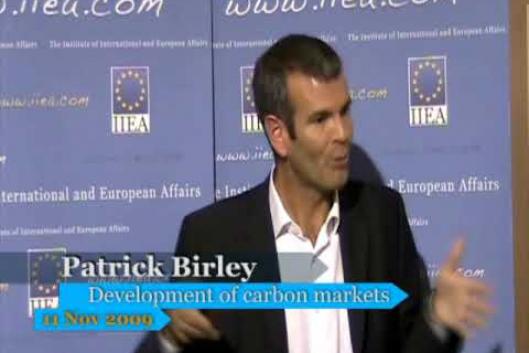Patrick Birley, the Chief Executive of the European Climate Exchange, knows a thing or two about carbon trading. He should do. He claims that about 95 per cent of all the carbon traded globally is traded through his exchange. So when he talks about carbon markets, we would do well to listen.
Here’s what he has to say about carbon trading: “It doesn’t reduce a single tonne of carbon going into the atmosphere. It’s got nothing to do with it. It’s all about the cap. The cap is the mechanism that produces a declining amount of carbon over the long term going into the atmosphere.”
This isn’t an anti-market, anti-globalisation anarchist speaking. It’s the head of the European Climate Exchange, talking"> in November 2009, at an event in Ireland, organised by the Institute of International and European Affairs. But if carbon trading does not reduce carbon emissions, what on earth is it for?
Unfortunately, on this point Birley’s presentation was a little more vague. “There are people making and losing money,” he explained. Of course, he’s one of those who is making money. “I am certainly a profit making company aiming to make as much profit as possible for my shareholders and I’m unashamed about that.”
But carbon trading is not only about making money. After repeating that his company does nothing to reduce the amount of carbon going into the atmosphere, Birley said, “We are helping those who are reducing their carbon to manage the associated risks.”
On one of his presentation slides, titled “Who is the market?”, Birley lists four groups: hedgers, investors, arbitrageurs and speculators. Anyone remember sub-prime? Wasn’t it triggered by precisely these groups of money-makers managing other people’s risk with other people’s money?
Earlier this year, I interviewed Jeff Horowitz, founder of Avoided Deforestation Partners, a US-based organisation that is lobbying for forest offsets to be included in US climate legislation. I asked Horowitz why he favoured trading in forest carbon credits when they do not, and cannot, reduce emissions. In five long paragraphs, his only answer to this question was to argue that “without the ability to leverage credible and environmentally robust REDD offsets, the reduction targets achievable by policy makers would be significantly scaled back.” Patrick Birley also hopes that carbon trading “will make industry more able to accept a steeper decline in terms of the cap.”
But when we look at the cap, there is little or no evidence to support this argument. During the fiasco at the UN climate negotiations in Copenhagen at the end of last year, the US and a handful of other countries presented the world with the Copenhagen Accord. The Accord mentions REDD, but the writers of the Accord took the already flimsy cap from the Kyoto Protocol and shot it so full of holes that it’s barely recognisable as a cap. An analysis by the Potsdam Institute for Climate Impact Research published in the Journal Nature in April found that: “The current national emissions reduction pledges accompanying the Copenhagen Accord will not limit global warming to two degrees Celsius. In fact, they imply a global mean temperature increase of more than three degrees Celsius this century.”
Polluting industry is, at least sometimes, very honest about their motivations for supporting carbon trading. American Electric Power (AEP) is the biggest burner of coal in the USA. In 2008, Diane Fitzgerald, AEP’s managing director of environment and safety, explained to Time magazine, “We’ll compare forestry offsets to projects like renewable energy, and we have to make the best financial decision.”
A year later, Michael G. Morris, AEP’s chief executive, told the Washington Post, “When Greenpeace says the only reason American Electric Power wants to do this is because it doesn’t want to shut down its coal plants, my answer is, ‘You bet, because our coal plants serve our customers very cost-effectively.’” Industry wants carbon trading so that it does not have to reduce emissions. At the same time, polluting industry can create the appearance of doing something by buying carbon credits.
This trade in a commodity that no one can see is expected to be a US$3 trillion market by 2020. That’s if the market doesn’t collapse completely before then. The US$7 billion dollars in fraud that was recently uncovered in the EU illustrates the potential for organised crime to get involved. Trading carbon won’t reduce emissions, but it will allow industry to lock in polluting technology.
If we could see meaningful emissions reductions, an end to exploration for new fossil fuels, an end to new coal-fired power plants and a structural shift to renewable energy production then perhaps the carbon trade would be an irrelevant side-show. As it is we can’t see any of these three things happening and the carbon trade is helping industry continue with business as usual. That, and making money, is what carbon trading is for.
By Chris Lang, http://chrislang.org
